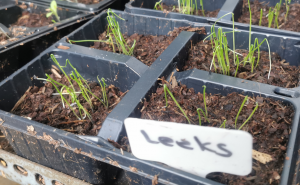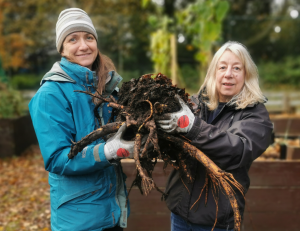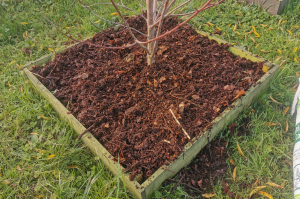
Introduction:
December is the time to relax and plan for next year. Take time this month to go through catalogues to decide what to grow, speak to other gardeners and allotmenteers to get inspiration, clean your pots and organise your tools ready for the new year – perhaps ask the Christmas fairy for a new toy?
For food growing, this month you can start onions and leek from seed. Salad crops started in October and November should be ready to harvest, and the food growing space can be tucked in for a rest.
Read the previous articles here:
January / February / March / April / May / June / July / August / September / October / November
If you are new to growing your own food and want to have a go, why not start this year? Email us for a free PDF guide to help you! Laura will also help via social media or email – laura.beardsmore@tcv.org.uk
Seeds to Sow in December:
Indoors, either in pots or module trays, you can start onion and leek from seed. Sow onion seed about 4cm apart, and sow leeks in a group. The onions will need more room to grow before being pricked out, whereas the leeks can stay in a bundle.
Successional Sowing:
If you have a heated greenhouse or growing area, you can keep sowing salad crops.
Planting Out in December:
Not a lot to do in December, as the ground is cold and wet, and maybe even frozen. Keep your plants indoors, ready to plant out in March and April.
November and December are the perfect time to lift and divide any rhubarb crowns. Use a spade (or maybe even a saw!) to divide the crown into pieces, then replant them spaced 3ft/90cm apart. Make sure the top of the crown is above the ground, and then mulch around it with leaf litter.
Harvesting Food in December:
Brassicas can be picked ready for a festive meal. Salad crops can be cut as soon as the leaves are big enough.
Potatoes, carrots, leek, parsnip, and any other root veg can also be lifted during the winter months. Some crops like parsnip benefit from a good frost before harvesting.
If you are on heavy wet clay soil, lift and store root veg in a cool, dry place. You could try putting the veg in some clean dry sand.
If you are using raised beds or pots, or have more favourable ground, you can leave root crops in until you need to lift and use them.
Putting the Garden to Bed:
Using leaf mulch, well-rotted manure, straw, cardboard (minus sellotape and labels), you can cover your raised beds over. Make sure you weigh down cardboard so it doesn’t blow away! These techniques are part of the ‘no-dig’ theory. Read more here.
You could leave leaf litter on the raised beds and grassy areas as the leaves will break down and feed the ground. Alternatively, make a leaf mulch bin and collect the leaves up and they will rot, ready to use as a good healthy mulch next winter.
For those of you who are pro-dig, you could also scatter green manure seed down over your food growing space, which will help put nutrients back into the ground. Read more here.
Getting Ready for January:
Read our GYO in January blog here!
Remember to tag us and share pictures with us on social media – find us on:
And if you want help and advice, why not join our Grow Well, Eat Well group on Facebook?


